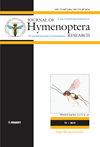Open在分类学意义上的获取:西部古北杜鹃的形态学和分子指南(膜翅目,姬蜂科)
IF 1.5
3区 农林科学
Q2 ENTOMOLOGY
引用次数: 0
摘要
在生物多样性危机的今天,通过准确和易于获取的分类修订来评估物种多样性比以往任何时候都更加重要。寄生蜂被认为是生命之树上最多样化和研究不足的群体之一。杜索娜·卡梅伦,1901年(姬蜂科,假蜂科)是达尔文黄蜂中442种物种最丰富的属之一,但尽管最近有了钥匙,物种鉴定对非专业人员来说是不可能的。在这项研究中,我们检查了来自瑞典和瑞士最近和历史收藏的约1500个杜索纳标本。我们提供了西部古北区125种杜索纳中57种的诊断特征和详细图版的摄影指南,方便了基于现有键的物种识别。我们在瑞典和瑞士的动物记录中分别增加了11种和3种。此外,我们基于45个物种的COI、CAD、ITS2、28S 4个标准标记,以及46个物种的可靠参考条形码库,重建了欧洲杜鹃的系统发育。尽管我们可以确定几个形态上不同的分支,但由于普遍的性状同质性,我们没有提出任何新的亚属。虽然大多数物种可以通过条形码很好地区分开来,但一些形态上截然不同的物种在这一标记上几乎没有歧视性的条形码序列(p距离< 2%),甚至是无特异性的,这表明条形码在达尔文黄蜂中的适用性存在局限性。这项研究表明,即使在瑞典和瑞士等研究充分的国家,被忽视的分类群清单也存在严重差距。由于这项研究使西部古北杜索纳的物种确定更加容易,我们鼓励更多的人,包括非专业人士,研究这个属。本文章由计算机程序翻译,如有差异,请以英文原文为准。
Open access in a taxonomic sense: a morphological and molecular guide to Western Palaearctic Dusona (Hymenoptera, Ichneumonidae)
In the present time of biodiversity crisis, assessing species diversity by accurate and accessible taxonomic revisions is more crucial than ever. Parasitoid wasps are considered as both one of the most diverse and under-studied groups in the tree of life. Dusona Cameron, 1901 (Ichneumonidae, Campopleginae) is with 442 species one of the most species - rich genera of Darwin wasps, but despite the existence of recent keys, species identification has proven difficult to impossible to non-specialists. In this study, we examined about 1,500 Dusona specimens from recent and historical collections in Sweden and Switzerland. We provide a photographic guide to diagnostic characters and detailed plates for 57 out of 125 Western Palaearctic Dusona species, facilitating species identification based on existing keys. We add 11 and 3 species to the faunistic records of Sweden and Switzerland, respectively. Furthermore, we reconstruct the phylogeny of European Dusona based on four standard markers (COI, CAD, ITS2, 28S) for 45 species, complemented with a reliable reference barcode library for 46 species. Even though we can identify several morphologically distinct clades, we do not propose any new subgenera due to prevalent homoplasy of characters. While most species are well separated by barcodes, several morphologically distinct species have barely discriminatory barcode sequences (p-distances < 2%) or are even paraphyletic in this marker, indicating limitations in the applicability of barcodes for Darwin wasps. This study reveals severe gaps in the inventories of neglected taxa even for well-studied countries such as Sweden and Switzerland. As this study makes species determination for Western Palaearctic Dusona more accessible, we encourage more people, including non-specialists, to work with this genus.
求助全文
通过发布文献求助,成功后即可免费获取论文全文。
去求助
来源期刊
CiteScore
2.60
自引率
15.40%
发文量
68
审稿时长
>12 weeks
期刊介绍:
The Journal of Hymenoptera Research is a peer-reviewed, open-access, rapid online journal launched to accelerate research on all aspects of Hymenoptera, including biology, behavior, ecology, systematics, taxonomy, genetics, and morphology.
All published papers can be freely copied, downloaded, printed and distributed at no charge for the reader. Authors are thus encouraged to post the pdf files of published papers on their homepages or elsewhere to expedite distribution. There is no charge for color.

 求助内容:
求助内容: 应助结果提醒方式:
应助结果提醒方式:


